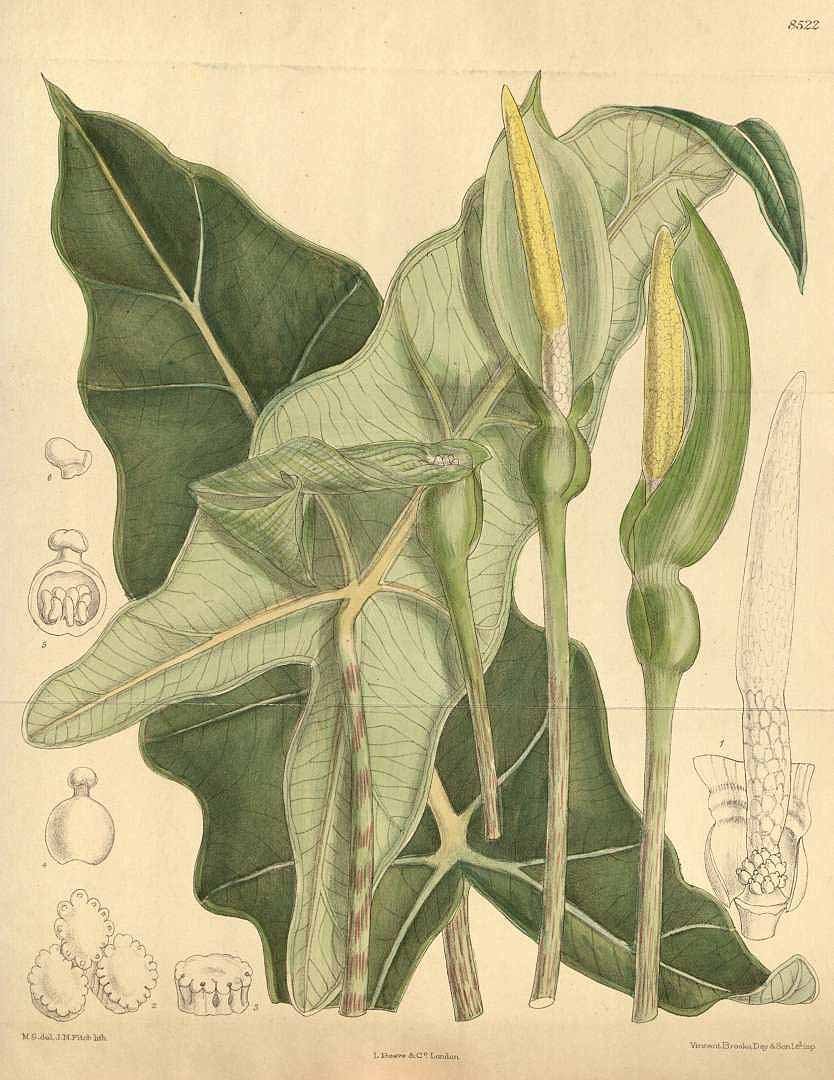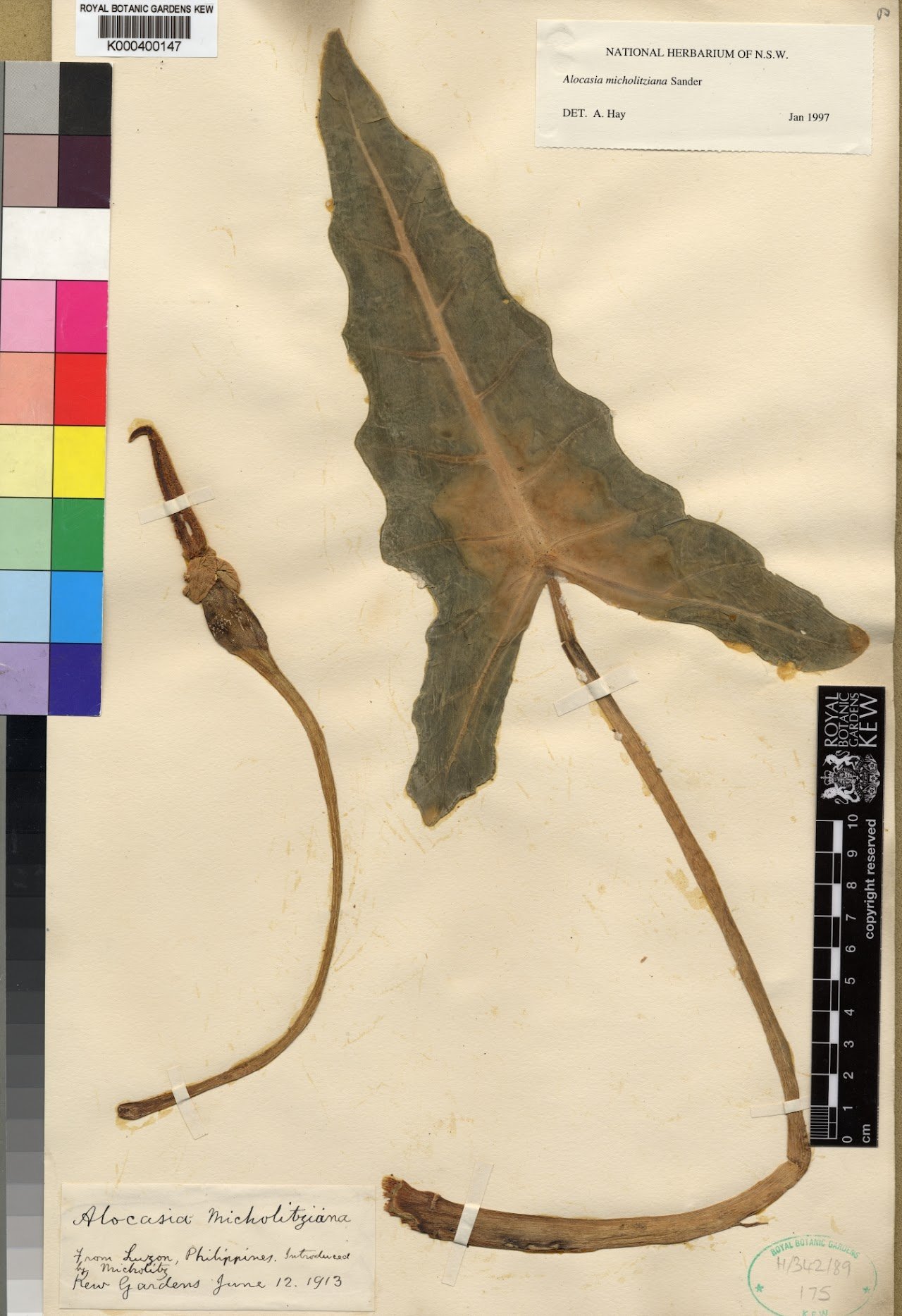ALOCASIA MICHOLITZIANA
ORIGINAL DESCRIPTION:
The caption below the first photo of Alocasia micholitziana (1912) incorrectly states this species is from Malaysia, when it is in fact from the Philippines
SYNONYMS: Alocasia ‘African Mask’, Alocasia ‘Green Velvet, Alocasia ‘Green Goddess’, Alocasia ‘Silver Vein’, Alocasia ‘Frydek’
DISTRIBUTION: Philippines; Luzon
Luzon mainland and associated islands
CLIMATE: Tropical humid climate
Humidity is moderate throughout the year, ranging from 60% to 70%
Temperature is varies between the seasons - within the range of 48°F/9°C to 88°F/31°C during the day. Minimum temperatures never dip below 45°F/7°C
Rainy and humid season (October to May) and a dry season between June and October. The average annual rainfall is 1,200 mm
ECOLOGY: In primary and secondary forest and roadside clearings at ca. 1200-1500 m altitude. This species is common and widespread, and presumably occurs over a somewhat wider altitudinal range than the limited available data indicate.
SPECIES DESCRIPTION:
Moderately robust herb; stem erect to decumbent, to ca. 50 cm long, ca. 4 cm diam.; leaves ca. 4-7 together, not interspersed with cataphylls; petiole to 45 cm long, sheathing in the lower ca. quarter to third, mottled brownish, reddish and/or purplish; blade rich velvety matt deep green adaxially, paler abaxially, sagittate, ca. 40 cm long x 13 cm wide, very shallowly to shallowly peltate; costae and primary veins white adaxially; anterior lobe ca. 20 cm long, rather broadly triangular, the margin very strongly to shallowly but distinctly undulate; anterior costa with 4-5 primary lateral veins on each side diverging at ca. 60-80° then curving distally to the margin; secondary venation flush on both sides, arising from the primary venation at a wide angle (ca. 90-100°) then curving to the margin; interprimary collective veins not or hardly differentiated; posterior lobes diverging at ca. 60-90°, narrowly triangular, the outer margins undulate, to ca. 11 cm long
INFLORESCENCE:
Inflorescences to ca. 4 together; peduncle to ca. 20 cm long; spathe ca. 14 cm long; lower spathe ovoid, ca. 3 cm long, green, separated from the limb by a rather abrupt constriction; limb ca. 11 cm long, basally somewhat reflexed and distally cucullate at anthesis, opening wide; spadix ca. three quarters the length of the spathe, sessile, ca. 9 cm long; female zone ca. 1 cm long (dry) x ca. 7 mm; ovaries globose, ca. 2.5 mm diam.: style ca. 1 mm, rather abruptly differentiated from ovary; stigma subglobose, weakly lobed; sterile interstice slender, ca. 7 mm long x 2 mm diam. at narrowest, the lower ring of synandrodia paler and larger than upper ones; male zone more or less cylindric, ca. 1.2 cm long x 5 mm wide; synandria rhombohexagonal, ca. 1.2 mm diam. (dry), opening by apical pores not capped by synconnective; appendix ca. 6 cm long, tapering to a narrow blunt tip. not or faintly constricted at junction with male zone, composed of irregular low elongate staminodia; fruiting spathe ca. 4 cm x 2 cm; fruit ca. 5 m diam. Infructescences turn from white to orange and deep red when successfully pollinated.
VARIEGATED FORMS: WHITE, MINT, YELLOW
ETYMOLOGY: The specific epithet was given after this species’ original collector, German botanist Wilhelm Micholitz:
The handsome Aroid […] is a native of the Philippines, where it was first encountered some fifteen years ago by Mr. Loher in the province of Benguet in the island of Luzon. It was encountered again by Mr. Micholitz, also in Luzon, when collecting there on behalf of Messrs. Sander & Sons, St. Albans, by whom it was introduced to cultivation about three years ago. Very nearly allied to the familiar Alocasia sanderiana, this new species differs by having smaller leaves, less deeply lobed at the margins, with a deeper and very different shade of green and without silvery borders to the almost straight (not distinctly curved) primary lateral veins. In our plant, too, the leaves are very rarely peltate, and when they are peltate they are so to a much less degree than is the case in Alocasia sanderiana. The spadix, too, is here nearly as long as the spathe, and its appendix is longer than the floriferous portion, whereas in Alocasia sanderiana the spadix is much shorter than the spathe and the appendix is shorter than the flower-bearing part. Evergreen in habit, Alocasia micholitziana is easily grown, and thrives well in a shady position in a hot moist stove. It requires an open compost, rich in humus, with abundant moisture at the root during the season of growth. A partial rest should be given during the winter months, the plant being kept somewhat drier at the root, and only sufficient water being supplied to enable it to retain its leaves. Propagation is readily effected by dividing the stem into sections, potting these up and plunging the pots in a moist case in brisk bottom heat until new growths are obtained.
NOTES:
1. An issue of Nomenclature
Perhaps one the greatest debates amongst Alocasia collectors is tied to Alocasia micholitziana, more precisely two of the most widely collected cultivars, and the proper names to call them by.
To better understand this conundrum, we need to travel back in time, first to 1983, with the first documented use of Alocasia micholitziana ‘Green Velvet’ in the name of a print by photographer Don Worth.
The next piece of the puzzle appears in 1984, when David Burnett published his seminal work on the Alocasia genus, ‘The Cultivated Alocasia’. At that time, there was an Alocasia micholitziana type species known, along with three cultivars, Alocasia micholitziana ‘Florida’, Alocasia micholitziana ‘Gigantea’, and Alocasia micholitziana ‘Green Velvet’
The type species and Alocasia micholitziana ‘Gigantea’ are quite rare in collections and predominantly grown only in the Philippines nowadays. Alocasia micholitziana ‘Florida’ did not pass the test of time, leaving Alocasia micholitziana ‘Green Velvet’ as one of the most populat Alocasia grown today.
This brings us to 1997/1998, when the majority of plant trading and ordering was still done via paper catalogues from the time’s largest nurseries.
Around that time, Glasshouse Works introduced the first cultivar of Alocasia micholitziana to the western markets, under the name Alocasia micholitziana variegated ‘Freydyk’ and it was described as such: “The velvety narrow leaves sport dramatic creamy splashes of variegation”. It is believed that ‘Freydyk’ was the name of the man who introduced the plant into cultivation.
Photo of the original yellow variegated Alocasia ‘Freydyk’ from Lester Kallus’ collection
Published in 2000, Deni Bown’s ‘Aroids | Plants of the Arum Family’ (2nd edition), lists Alocasia micholitziana ‘Maxkowskii’ as one of the circulating cultivar names
Photo of Alocasia micholitziana ‘Maxkowskii’ from Deni Bown’s Aroids | Plants of the Arum Family’ (2000)
Published in 2001, Armitage’s ‘Manual of Annuals, Biennials and Half-Hardy Perennials’ lists Alocasia micholitziana ‘Maxkowskii’ as the only cultivar in circulation, proving that this name was now the most widely used name among collectors and botanists, and referred to the green variety described by Burnett as Alocasia micholitziana ‘Green Velvet’
Armitage’s Manual of Annuals, Biennials and Half-Hardy Perennials, P. 44 (Published in 2001)
Around 2002, Agristarts added Alocasia micholitziana to their offering, which they dubbed Alocasia micholitziana ‘Frydek’’, most likely a typo, as the plant was very much like Glasshouse’s Alocasia micholitziana ‘Freydyk’, without its variegation, and akin to the original Alocasia micholitziana ‘Green Velvet’ from the 1980s.
Though over time ‘Frydek’ has become a household name in the Alocasia world, often being one of the first names a collector will encounter, it behooves all readers and Alocasia collectors to respect botanical precedence, and refer to the green cultivar as Alocasia micholitziana ‘Green Velvet’, or if one does not consider David Burnett’s 1984 text botanical literature, Alocasia micholitziana ‘Maxkowskii’, and to variegated cultivars as Alocasia micholitziana ‘Frydek’ (see image below).
LariAnn Garner made an interesting point, that the most particular growers do not generally accept names introduced by nurseries, or believe chimeric variegates (due to their inherent unstable nature) should be given cultivar names.
According to her, the most acceptable names for the current plant in circulation should be Alocasia micholitziana ‘Green Velvet’ (as first introduced by David Burnett).
She also suggests chimeric variant forms of a cultivar should be given a modifier to indicate the presence of variegation (e.g. Alocasia micholitziana 'Green Velvet', cv. 'aureo-variegata' (for the yellow variegated form))
2. Other notes
Selection of the designated specimen is based on the facts that it is fertile and preserved from a plant cultivated at Kew, annotated by Brown as Alocasia micholitziana and as obtained from Sander's nursery and originally collected by Micholitz after whom the species was named.
Those facts would appear to form an adequate indirect link between the specimen and the plant on which Sander based his description; indeed they are quite probably clonally identical.
Madulid (pers. comm.) notes that this species occurs in several varieties. These are not clearly evident from herbarium material, though there is sufficient variation for a number of horticultural varieties to have been recognised (Burnett, 1984). Alocasia micholitziana is distinguishable from Alocasia sanderiana, with which it shares white major venation and undulate leaf margins, by its paler, brighter, matt green leaf surface - not purple abaxially, and by the leaf bases not subtended by cataphylls except at the beginning of a sympodial module. Moreover, the leaf of A. micholitziana is less deeply peltate than that of Alocasia sanderiana.
Other specimens seen: Luzon, Ifugao Prov., Banaue, Bogner 1631 (M); Ifugao prov., Banaue, Bayninan, Conklin & Buwaya PNH 80620 (GH, L); Laguna Prov., Los Banos (Mt Maquiling), Elmer 17769 (BO, CAL, GH, NY); Benguet Prov., Loher 2441 (K); Rizal Prov., Loher 15005 (UC); Ifugao Prov., Banaue, Poitan, Liwang, Mendoza PNH 37182 (L); Laguna Prov., Mt Makiling, along path from College of Agriculture, Nicolson 843 (L, US).
CULTIVARS:
HYBRIDS:
Alocasia ‘Frydek-Bullata’ (Alocasia micholitziana ‘Green Velvet’ x Alocasia sinuata)
Alocasia ‘Gold Magnet’ (Alocasia macrorrhizos ‘New Guinea Gold’ x Alocasia micholitziana ‘Green Velvet’)
Alocasia ‘Golden Bone’ (Alocasia micholitziana ‘Green Velvet, x Alocasia cuprea)
Alocasia ‘Moresby’ (Alocasia micholitziana x Alocasia longiloba)
Alocasia ‘Raven’ (Alocasia micholitziana ‘Frydek’ x Unknown)
REFERENCES:
Deni Bown: Aroids | Plants of the Arum Family
Armitage’s Manual of Annuals, Biennials, and Half-Hardy Perennials
Personal correspondence with R. McCracken, David Burnett and LariAnn Garner









































